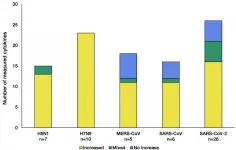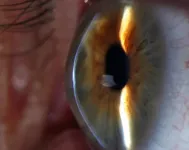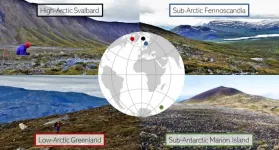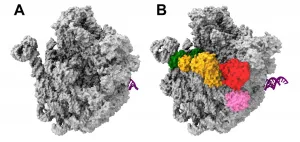(Press-News.org) TAMPA, Fla. - Genetic alterations of the KRAS gene are some of the most common mutations in lung cancer patients, but unfortunately these patients have few effective treatment options. Drugs that target the G12C mutation in KRAS have shown some activity in lung cancer; however, alternative signaling pathways are often activated that bypass the KRAS inhibitor, resulting in drug resistance. In a new article published in Clinical Cancer Research, Moffitt Cancer Center researchers show that various subtypes of lung cancer cells activate different signaling pathways in response to KRASG12C inhibitor treatment. These results may help identify potential combination therapy approaches and guide treatment decisions for lung cancer patients in the future.
The G12C mutation of KRAS occurs in approximately 16% of lung adenocarcinomas. Several drugs that target this specific mutation are in clinical development and have shown activity in some lung cancer patients, but these drugs are less effective in certain patients. As a result, combination treatment with other targeted agents may be necessary to see a benefit, but it is not clear which combination treatment strategies would work best.
"Given the diverse responses observed in both preclinical models and human patients, it is critical to understand how cells escape from targeted inhibition, which pathways contribute to resistance and how to predict pathway utilization for escape to enable precision medicine in the form of combination therapy," said Eric Haura, M.D., associate center director of Clinical Science at Moffitt.
The researcher team performed a series of preclinical studies using a technique called mass spectrometry to determine how cells respond to KRASG12C inhibitor treatment and to characterize their different responses. They treated a panel of KRASG12C mutant lung cancer cell lines with the KRASG12C inhibitor and discovered that each cell line displayed varied sensitivity to the drug, which was associated with different protein signaling patterns after treatment.
They characterized the panel of cell lines into either an epithelial or mesenchymal cell type. Epithelial cells are specialized cells that line organs and vessels and have strong cell connections between them, while mesenchymal cells are less specialized, associated with connective tissues, and are typically more motile. Epithelial and mesenchymal cells are known to express particular proteins and act in certain ways; however, they can change protein expression patterns and become similar to the alternative cell type under certain conditions.
The researchers discovered that the cell line that was sensitive to the KRAS inhibitor and displayed epithelial characteristics activated the HER2 and HER3 signaling pathways after KRAS inhibitor treatment, and cotreatment with a drug that targets these proteins resulted in greater cell death than either agent alone. They also demonstrated that activation of the downstream proteins SHP1, SOS1 and IRS1 contributed to responses after KRASG12C inhibitor treatment in this cell line.
After assessing signaling responses of the KRAS inhibitor resistant and moderately sensitive lung cancer cell lines, which have mesenchymal characteristics, they found that activation of the FGFR1 and AXL signaling pathways mediates resistance to KRAS inhibitor treatment in these cell lines, respectively, and that co-treatment with an FGFR or AXL inhibitor sensitized the cells to KRAS inhibition.
These data support the idea that the ideal therapy for lung cancer patients cannot be a one-size-fits-all approach. The researchers hope their results and experimental approach can be used to develop targeted cotreatment approaches for patients.
"Our data highlight the importance of phosphoproteomics-based approach to identify tumor specific adaptive rewiring, which can be utilized to aid personalized patient care in KRASG12C mutants," said Haura.
INFORMATION:
This study was supported by funding from the State of Florida's Bankhead Coley Program (5BC07), the Moffitt Lung Cancer Center of Excellence and the National Cancer Institute (P30-CA076292).
About Moffitt Cancer Center
Moffitt is dedicated to one lifesaving mission: to contribute to the prevention and cure of cancer. The Tampa-based facility is one of only 51 National Cancer Institute-designated Comprehensive Cancer Centers, a distinction that recognizes Moffitt's scientific excellence, multidisciplinary research, and robust training and education. Moffitt is the No. 11 cancer hospital and has been nationally ranked by U.S. News & World Report since 1999. Moffitt's expert nursing staff is recognized by the American Nurses Credentialing Center with Magnet® status, its highest distinction. With more than 7,000 team members, Moffitt has an economic impact in the state of $2.4 billion. For more information, call 1-888-MOFFITT (1-888-663-3488), visit MOFFITT.org, and follow the momentum on Facebook, Twitter, Instagram and YouTube.
Atmospheric carbon dioxide (CO2) is a major driver of global warming, but this gas could also serve as a valuable resource. Researchers at KAUST have developed an efficient catalyst that uses light energy to convert CO2 and hydrogen into methane (CH4). This counteracts the release of CO2 when methane is burned as a fuel.
Many researchers worldwide are exploring ways to convert CO2 into useful carbon-based chemicals, but their efforts have been limited by low efficiencies that restrict the potential for large-scale application.
"Our approach is based on the synergistic combination of light and heat, known as the photothermal effect," says postdoc Diego Mateo. He explains that the heat is generated by the interaction of light with the catalyst, ...
Spikes in temperature can affect a plant's fertility, resulting in a reduction of yield and economic loss
How plants can protect themselves from stress has been studied by a consortium led by the University of Warwick
Two argonaute-like proteins protect the plant's fertility, understanding these proteins is critical to safeguarding crop production
As Temperatures rise due to global warming the need to protect plants from stressful conditions has increased, as stress can cause a loss in yield and cause further impact economically. A consortium led by the University of Warwick have successfully identified ...
Respiratory viruses such as SARS-CoV-2 (causing COVID-19) can often catalyse an overactive immune response that leads to a life-threatening cycle, known as a cytokine storm. Analysing cytokine responses from patients infected with SARS-CoV-2 and similar common respiratory viruses has unearthed glaringly important differences in how SARS-CoV-2 affects cytokines compared to other common respiratory viruses.
The comprehensive data resource aims to help specialists identify better treatments and diagnosis of underlying causes that can cause the deadly cytokine storm.
Scientists at the ...
In order to avoid the occurrence of such effects, the Federal Institute for Health Protection of Consumers and Veterinary Medicine (BgVV) recommended guidance values for maximum THC levels in various food groups in 2000. The guidance value for beverages was given as 0.005 mg/kg, for edible oils with 5 mg/kg and for all other foods with 0.150 mg/kg. In 2018, the BfR came to the conclusion that these values no longer correspond to current scientific knowledge.
Instead, the BfR recommends that the toxicological assessment of hemp-containing foods be carried out on the basis of the acute reference dose (ARfD) of 1 microgram Δ-THC/kg body-weight derived by the European Food Safety Authority (EFSA) in 2015. The ARfD specifies the estimated maximum quantity ...
DNA nanotechnology - the research field using DNA molecules as building material - has developed rapidly during recent years and enabled the construction of increasingly complex nanostructures. DNA nanostructures, such as DNA origami, serve as an excellent foundation for nanocarrier-based drug delivery applications, and examples of their use in medical treatments have already been demonstrated. Although the stability of such DNA nanostructures under physiological conditions can be improved, little is known about their digestion by endonucleases, which, found everywhere in our blood and tissues, are responsible for destroying foreign DNA in our bodies.
To tackle this emerging question, a ...
Scientists have taken a significant step forward in their search for the origin of a progressive eye condition which causes sight loss and can lead to corneal transplant.
A new study into keratoconus by an international team of researchers, including a University of Leeds group led by Chris Inglehearn, Professor of Molecular Ophthalmology in the School of Medicine, has for the first time detected DNA variations which could provide clues as to how the disease develops.
Keratoconus causes the cornea, which is?the clear outer layer?at the front of the eye, to thin and bulge outwards into a cone shape over time, resulting in blurred vision and sometimes blindness. It usually emerges in young adulthood, often with lifelong ...
Researchers are in the search for generalisable rules and patterns in nature. Biogeographer Julia Kemppinen together with her colleagues tested if plant functional traits show similar patterns along microclimatic gradients across far-apart regions from the high-Arctic Svalbard to the sub-Antarctic Marion Island. Kemppinen and her colleagues found surprisingly identical patterns.
It is widely known that global vegetation patterns and plant properties follow major differences in climate. Yet, it has remained a mystery how well the same rules can be applied at very local scales. Are responses to the environment similar in plant communities ...
Ribosome formation is viewed as a promising potential target for new antibacterial agents. Researchers from Charité - Universitätsmedizin Berlin have gained new insights into this multifaceted process. The formation of ribosomal components involves multiple helper proteins which, much like instruments in an orchestra, interact in a coordinated way. One of these helper proteins - protein ObgE - acts as the conductor, guiding the entire process. The research, which produced the first-ever image-based reconstruction of this process, has been published in Molecular Cell*.
Ribosomes are an essential component of all living cells. Frequently referred to as 'molecular protein factories', they translate genetic information into chains of linked-up ...
What can you see on this picture (next to thearticle)? Say what comes to your mind immediately!
If you said „star", you focus rather on the details, if you said „sun", then rather on the global pattern.
People can be different in whether they typically see the forest or the trees, but the dominant attentional mode is focusing first on the whole, and then on the details. This is the same with children. Or so it has been until now! Children of the Alpha Generation (who has been born after 2010) typically grow up with mobile devices in their hands which seems to change how they perceive the world, as Hungarian researchers showed.
The Alpha Generation Lab of Diagnostics and Therapy Excellence Programme at Eötvös Loránd University (Budapest) studies ...
Materials - Quantum building blocks
Oak Ridge National Laboratory scientists demonstrated that an electron microscope can be used to selectively remove carbon atoms from graphene's atomically thin lattice and stitch transition-metal dopant atoms in their place.
This method could open the door to making quantum building blocks that can interact to produce exotic electronic, magnetic and topological properties.
This is the first precision positioning of transition-metal dopants in graphene. The produced graphene-dopant complexes can exhibit atomic-like behavior, inducing desired properties in the graphene.
"What could ...






